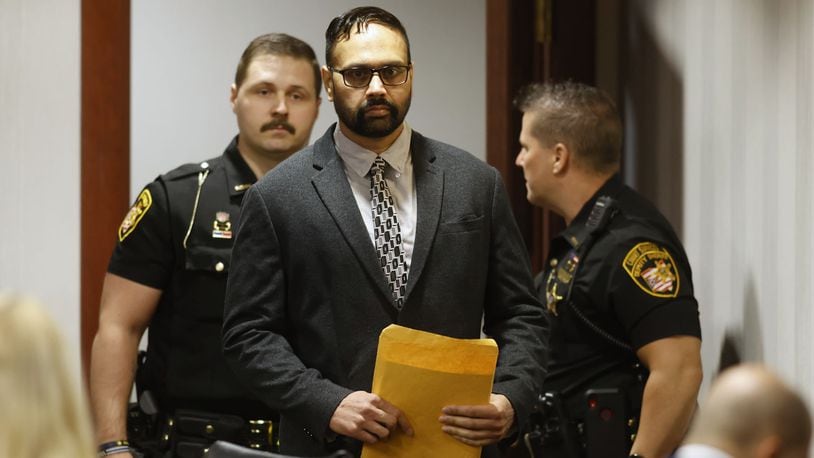His first trial ended with a hung jury in October 2022. But this with time a new defense team, he opted to let a three judge-panel weigh the evidence.
The defense and prosecution agree Gurpreet Singh was present when four of his family members were shot and killed in their West Chester Twp. apartment, but the prosecutors say he was the killer, and the defense says he was a witness.
A parade of West Chester police officers testified Tuesday and Wednesday about evidence collection at the shooting scene on April 20, 2019, including a Beretta handgun with ammo in the closet of Singh’s bedroom and $930 cash on a prayer table beside one of the victims and $8,250 cash in a pink purse also located in the master bedroom.
Credit: Nick Graham
Credit: Nick Graham
The panel, comprised of Judges Greg Howard, Keith Spaeth and Greg Stephens, saw photos of the gun stuffed into a bag with Prosecutor Josh Muennich pointing out the gun was not the murder weapon, but evidence the “defendant had access to the firearm and ammunition at the time for the offense.”
The defense said Singh witnessed the shooting deaths of his family, but did not kill them, alluding to others with criminal backgrounds who had an ongoing land dispute with Hakikat Singh Pannag as suspects.
The murder weapon was located in apartment complex pond by a dive team two days later. The judges were shown the Ruger that had its serial number destroyed.
A portion of body camera was played in court as Sgt. Travis Oakes questioned Singh, who was distressed and paused answering questions, but identified the people living in the apartment.
Singh told the officer friends call him “Gary” and asked about his wife.
“Please tell me if she is OK?” Singh asked.
Oakes said, “Everyone inside is deceased.”
Singh did not understand the word deceased and Oakes told him, “dead.”
He asked about his three children several times, saying they were with his brother and sister.
When the man Singh called is brother, Maninder Sekhon Singh, showed up at the scene, Oakes said he was a person of interest. But a video was found at a UDF showing Maninder, his sister Harmanjot Sekhon, Singh’s children, and Harmanjot Sekhon there near the time of the murders.
During cross examination, defense attorney Alexandra Deardorff pointed out Oakes said he thought it was “odd” that Harmanjot did not call the Singhs after learning something happened at the residence. And at the time of the questioning Oakes said he did not believe he was getting the “whole truth.”
Also presented Tuesday was evidence of two homes purchased by Singh in an Indianapolis neighborhood, one for himself and Navkiran Kaur, who prosecutors way was Singh’s mistress.
Also played in court was the 911 call placed by Singh. He is crying and out of breath saying, “wife and family down … bleeding.”
The call was placed to West Chester dispatch at 9:42 p.m.
Singh said, “Please help. They are bleeding ma’am.”
The dispatcher asked, “Sir, did you do something to them?”
Singh answered, “No, I just got home.”
During opening statements, Assistant Prosecutor Jon Marshall said in addition to victims’ blood, gunshot residue and DNA found on Singh, GPS evidence can place Singh in the parking lot of the apartment complex at 9:03 p.m. That is 39 minutes before the 911 call was placed.
West Chester Police Sgt. Michael Bruce took the stand as his body camera from the homicide scene was played. Singh is in the the breezeway of the apartment complex wearing a red shirt with blood visible.
Bruce asked Singh, “Do you know who may have done this?
Singh is on camera shaking his head no.
Deardorff said during opening statements Singh was the suspect because he lied to police and they looked no further.
She said he was present when his family was killed, but he did not do it, according to the defense attorney.
“He is here because he lied. In reality he was there and witnessed the brutality,” Deardorff said,. “He probably should not have lied to the police; it does not make him a killer.”
Forensic pathologist Dr. Karen Looman testified Monday about the injuries all for victims sustained and showed photos of autopsies she performed.
All four victims were shot in the head, some multiple times.
Credit: Nick Graham
Credit: Nick Graham
Marshall said Singh chose the time and place for the shootings where he knew his family would be the most vulnerable, shooting Hakikat as he slept, his wife as she prepared tea in the kitchen and the others at they watched television.
At the time of the homicides, Singh was having an affair with a woman in Indianapolis whom he gave $20,000 cash to purchase a house, bought a car and paid a mortgage, Marshall said, pointing to motive.
Additionally, there was a strained relationship between Singh and his father-in-law with evidence of hostile demands by Singh to Hakikat for money, according to prosecutors.
Credit: Nick Graham
Credit: Nick Graham
About the Author
